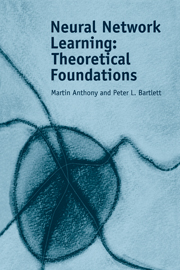Book contents
- Frontmatter
- Contents
- Preface
- 1 Introduction
- Part one Pattern Classification with Binary-Output Neural Networks
- Part two Pattern Classification with Real-Output Networks
- Part three Learning Real-Valued Functions
- Part four Algorithmics
- 22 Efficient Learning
- 23 Learning as Optimization
- 24 The Boolean Perceptron
- 25 Hardness Results for Feed-Forward Networks
- 26 Constructive Learning Algorithms for Two-Layer Networks
- Appendix 1 Useful Results
- Bibliography
- Author index
- Subject index
26 - Constructive Learning Algorithms for Two-Layer Networks
Published online by Cambridge University Press: 26 February 2010
- Frontmatter
- Contents
- Preface
- 1 Introduction
- Part one Pattern Classification with Binary-Output Neural Networks
- Part two Pattern Classification with Real-Output Networks
- Part three Learning Real-Valued Functions
- Part four Algorithmics
- 22 Efficient Learning
- 23 Learning as Optimization
- 24 The Boolean Perceptron
- 25 Hardness Results for Feed-Forward Networks
- 26 Constructive Learning Algorithms for Two-Layer Networks
- Appendix 1 Useful Results
- Bibliography
- Author index
- Subject index
Summary
Introduction
In this chapter, we consider learning algorithms for classes F of realvalued functions that can be expressed as convex combinations of functions from some class G of basis functions. The key example of such a class is that of feed-forward networks with a linear output unit in which the sum of the magnitudes of the output weights is bounded by some constant B. In this case, the basis function class G is the set of functions that can be computed by any non-output unit in the network, and their negations, scaled by B. We investigate two algorithms. Section 26.2 describes Construct, an algorithm for the real prediction problem, and Section 26.3 describes Adaboost, an algorithm for the restricted version of the real classification problem. Both algorithms use a learning algorithm for the basis function class to iteratively add basis functions to a convex combination, leaving previous basis functions fixed.
Real Estimation with Convex Combinations of Basis Functions
Theorem 14.10 (Section 14.4) shows that any convex combination of bounded basis functions can be accurately approximated (with respect to the distance dL2(P), for instance) using a small convex combination. This shows that the approximate-SEM problem for the class co(G) can be solved by considering only small convex combinations of functions from G. In fact, the problem can be simplified even further. The following theorem shows that we can construct a small convex combination in an iterative way, by greedily minimizing error as each basis function is added.
- Type
- Chapter
- Information
- Neural Network LearningTheoretical Foundations, pp. 342 - 356Publisher: Cambridge University PressPrint publication year: 1999

